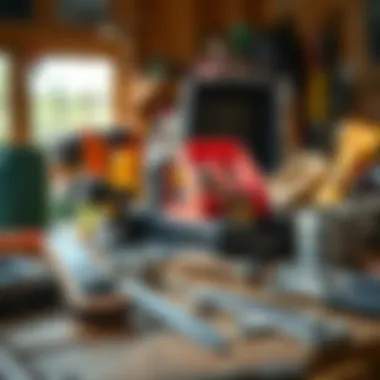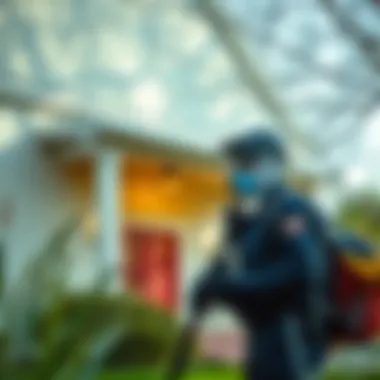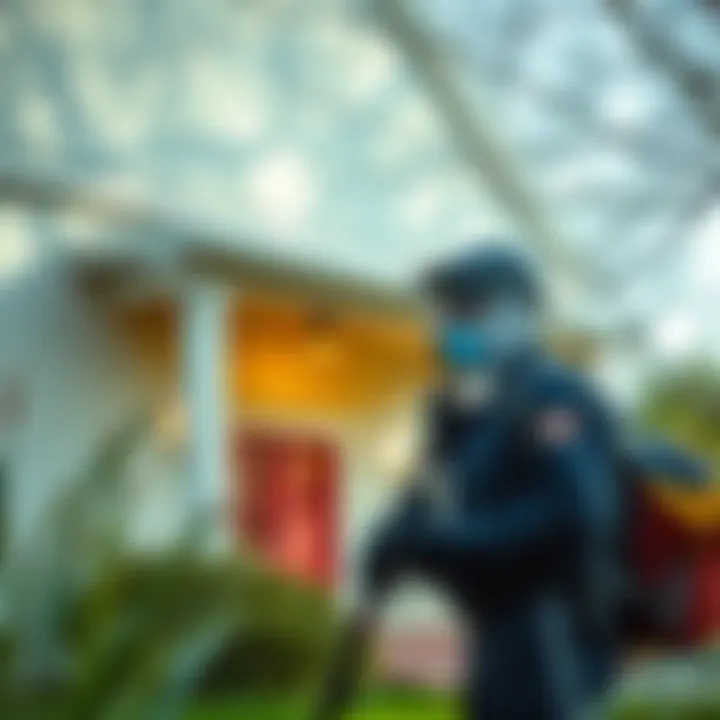Finding a Pest Inspector: A Complete Guide


Intro
Finding a reliable pest inspector is no small feat, particularly when the stakes are high. Pests may sneak into your home, exacerbating allergies and causing structural damage. Recognizing the importance of these inspections is key; it’s about more than just eliminating creepy crawlies. It’s about protecting your investment, health, and peace of mind.
Pest control has evolved over the years, catching up with modern technology and methods to ensure effectiveness and sustainability. However, understanding how to navigate the realm of pest inspections remains critical. This guide aims to arm you with the information you need to make sound decisions in selecting a pest inspection service.
Key Insights
Overview of the Topic
The reality is that the number of pests can escalate quickly if not managed properly. In agriculture and horticulture, pest inspections can mean the difference between a bountiful harvest and devastating crop loss. Understanding pest behavior is essential not just for homeowners but also for farmers and agricultural enthusiasts.
Moving deeper, we should recognize that pest control is not solely about eradication. It also encompasses proactive measures to prevent infestations. Selecting an inspector entails looking for qualifications, experience, and familiarity with local pest species.
Importance in Agriculture/Horticulture/Agronomy
In the agricultural realm, pest inspectors perform vital functions. The value of their expertise can hardly be overstated. They help identify threats not just to crops, but to the ecosystem as a whole. Using modern diagnostic tools, they can offer insights that traditional methods simply cannot muster. With crops susceptible to a diverse range of pests, local knowledge is irreplaceable.
For farmers, continuous monitoring for pests means maintaining quality yield while adhering to safety regulations. This practice supports the foundation of sustainable agriculture, where the focus is on keeping the environment healthy.
Sustainable Practices
Eco-Friendly Techniques
Today, pest management is shifting toward more sustainable practices. Techniques such as integrated pest management (IPM) and biological control are becoming more prevalent. These methods prioritize sustainability, often using natural predators or biological solutions instead of harsh chemicals. For instance, introducing ladybugs can naturally combat aphid populations without the environmental fallout of pesticides.
Case Studies on Sustainability
In recent years, certain farms have successfully implemented sustainable pest management strategies. For example, organic farms in California have reported significant reductions in pest populations by rotating crops and using resistant varieties. The results indicate that a holistic approach not only nurtures the environment but also boosts farm productivity.
Tools & Resources
Essential Equipment and Technologies
As pest management evolves, so too does the technology that supports it. Drones equipped with thermal imaging are now assisting inspectors in identifying infestations early on. Such innovative tools can help streamline the inspection process, ensuring that no pest goes unnoticed.
Recommended Books and Readings
To delve deeper into the world of pest management, consider exploring the following resources:
- The Pest Control Bible by Michael M. Potter for a comprehensive look at pest management options.
- Integrated Pest Management: Concepts, Tactics, Strategies and Case Studies by Edward B. Radcliffe, which offers a detailed view of IPM practices.
- Websites like University of California Agriculture and Natural Resources provide ongoing research and practical tips for pest control.
Prelude to Pest Inspection
Pest inspections serve as an essential pillar in maintaining a healthy and safe environment, particularly for those engaged in agriculture and farming. Regular inspections hold significance not just as a reactive measure but as a proactive approach to pest management. Understanding how pest inspections work and the value they provide can directly impact your crop yield and the overall health of your property.
Understanding Pest Inspections
When we talk about pest inspections, we're not merely addressing the act of checking a property for unwanted critters. It encompasses a detailed assessment that identifies pest presence, evaluates potential threats, and recommends actionable solutions. Imagine it as a health check-up for your crops or land—pests, whether they're insects or rodents, can jeopardize your hard work swiftly and silently.
Inspectors typically follow a systematic method. They start by assessing visible signs of infestation like droppings, nests, or damage to plants. An experienced pest inspector knows where to look and what to look for; their expertise means nothing slips through the cracks. The visual inspection is often complemented by other methods, such as thermal imaging or pheromone traps.
It’s not just about what you can see on the surface, either. Many pests, like termites, create damage that's hidden from plain sight, making it crucial for a trained eye to delve deeper. Failure to recognize these threats early on can lead to long-lasting repercussions, including costly repairs or even complete loss of crops.
Why Regular Inspections Matter
Regular pest inspections are akin to routine maintenance for machinery; they help you identify issues before they snowball into more significant challenges. Not all pests make their presence known immediately. Some, like root maggots, can be lurking below the surface, causing havoc while you may think everything is fine.


"An ounce of prevention is worth a pound of cure."
In agriculture, this saying could not ring truer. A diligent pest inspection can prevent months or even years of investment from being undone overnight. Here’s a closer look at the benefits of maintaining a regular inspection schedule:
- Early Detection: Detecting pests in their early stages allows for targeted interventions, saving both time and resources.
- Cost Savings: Addressing issues before they spiral out of control significantly decreases the potential costs involved in pest eradication.
- Peace of Mind: Knowing that your property undergoes regular evaluations fosters assurance that your crops remain healthy and pest-free.
- Sustainability: Implementing preventive measures through timely inspections promotes environmentally friendly practices, reducing the reliance on pesticides.
In summary, pest inspections are not an optional extra but an integral part of property and agricultural management. By choosing to invest in regular evaluations, you safeguard the health of your crops and ensure a thriving farming operation by keeping pests at bay.
Finding a Local Pest Inspector
Choosing a local pest inspector can feel like searching for a needle in a haystack. However, this step is both crucial and foundational to effectively managing pest issues. Homeowners, especially those affiliated with agriculture, need a pest inspector who understands regional pest behavior, local ecology, and specific crop vulnerabilities. Finding someone nearby not only streamlines the process but allows for quicker response times when problems arise. Local experts are adept at pinpointing pest hotspots characteristic of an area, meaning they can offer tailored solutions rather than one-size-fits-all fixes.
Utilizing Online Resources
The internet can be a double-edged sword when it comes to searching for pest inspectors. On one hand, it provides a plethora of information at your fingertips; on the other, it may also lead to misinformation or overwhelming choices. Start by using search engines to find pest control specialists in your locality. Websites, including Yelp and Angie's List, allow customers to leave reviews. Reading these reviews can highlight the strengths and weaknesses of specific inspectors. Additionally, local agriculture extension services often have lists of recommended professionals, delivering peace of mind that these suggestions are reliable.
For instance, if you live in Kansas, checking the Kansas State University Extension's resource page might yield valuable recommendations. Moreover, don't overlook forums and discussion boards, like the ones on Reddit, where local farmers may share firsthand experiences about pest inspectors in your area.
Seeking Recommendations
While the internet is handy, the ol' tried-and-true word-of-mouth still packs a punch. Speak to your neighbors, fellow farmers, or local agriculture groups. They've likely had their share of pest encounters and might have strong opinions on inspectors they've worked with. Ask specific questions, like the inspector’s timeliness, thoroughness, and follow-up practices.
Receiving a direct referral from a trusted source can save you time and diminish any risks involved. Fellow farmers might also provide insights on what to expect, which can dramatically reduce your stress if you are facing a pest crisis.
Evaluating Credentials
Now that you've gathered a list of potential candidates, it’s time to roll up your sleeves and do some digging. Start with credentials—ask to see their licenses, insurance, and professional affiliations. In many areas, pest inspectors must have certain certifications to operate legally. Inquire if they belong to professional organizations like the National Pest Management Association or any local agriculture groups. These credentials are not just decorations; they signify ongoing training and adherence to standardized practices.
Furthermore, probe into their experience as well. If you're dealing with specific crops or types of pests, it's wise to consider inspectors who have specialized knowledge in those areas. You wouldn’t want a generalist treating a specific problem without the right expertise. Knowing what certifications and experiences matter is paramount.
"A qualified pest inspector can save more than crops; they can save the day."
Finding a local pest inspector involves more than just picking a name from a list. With some research and networking, you can uncover a professional who meets your needs and helps tackle those pesky invaders effectively.
Key Qualifications for Pest Inspectors
When it comes to pest management, not just anyone can hold the title of a pest inspector. Engaging the right professional can mean the difference between a swift resolution and a drawn-out battle with unwanted nuisances. Therefore, understanding the key qualifications necessary for pest inspectors is not only prudent, it’s essential for making an informed choice.
Certifications and Licenses
One of the first markers of a competent pest inspector is their certification and licensing. Each state has its own regulatory body that sets the standard for pest control professionals. This often involves specific training programs and tests that cover critical aspects of pest management. A licensed inspector has typically completed education that dives deep into the biology of pests, proper pesticide application, and integrated pest management strategies.
When investigating an inspector’s qualifications, be certain to check for recognition from organizations such as the National Pest Management Association (NPMA) or local equivalents. If they don’t have these certifications displayed prominently, it could be a red flag. Always ask for verification, as it helps establish trust. Remember, not all licenses are created equal; some may allow for broader ranges of pest management practices than others.
It’s vital to verify that your pest inspector is licensed and holds relevant certifications. This is not just a formality, it’s your first line of defense against ineffective treatments.
Experience and Expertise
While certifications are important, experience and expertise are what truly sets apart a mediocre pest inspector from one who will hit the ground running. A seasoned inspector will have dealt with a variety of pest problems over the years, understanding the nuances of different infestations. This hands-on knowledge pays dividends, especially when confronting complex pest issues that may require customized solutions.
For example, a professional who has spent years managing termite infestations in a specific region will have valuable insight into particular methods and practices that are effective in that locale. Moreover, asking about how long they’ve been in the field, the types of jobs undertaken, and customer testimonials can provide rich context to their capabilities. It’s all about ensuring that the person you hire has the tricks up their sleeve to tackle whatever hassle they encounter.
Insurance and Liability Coverage
The question of insurance and liability coverage often goes overlooked, yet it’s incredibly vital. A reputable pest inspector should carry both liability insurance and worker's compensation coverage. This is not just standard practice; it protects you as a homeowner from any mishaps that may occur during the pest control process.
If an inspector causes damage to your property or gets injured while on the job, their liability insurance will cover such events. This means you won’t be stuck carrying the burden if something goes south. Confirm that the inspector you’re considering is insured, and don’t hesitate to ask for documentation that verifies their coverage. It can save you from a world of headaches and potential financial loss down the road.
In summary, understanding the qualifications that mark a proficient pest inspector is key for any homeowner or agriculture farmer wary of pest infestations. Certifications, experience, and insurance play a pivotal role in ensuring the professional you opt for has the competence and protection necessary to handle your pest issues effectively.


Types of Pests Commonly Encountered
Understanding the types of pests you might encounter is essential when considering pest control. Awareness of these pests helps homeowners and farmers to be alert and proactive, minimizing damage and other imminent risks. Let's delve into the main categories of pests that commonly show up around residential and agricultural properties.
Rodents and Insects
Rodents and insects are perhaps the most notorious of pests. Rodents, like mice and rats, are not just a nuisance; they can transmit diseases and cause significant property damage. Their gnawing habits make them adept at infiltrating homes, chewing through wires, and even creating structural issues.
Insects, on the other hand, range from annoyances like mosquitoes and cockroaches to more damaging pests such as ants and bed bugs. With peculiar habits and survival tactics, these tiny invaders can quickly become major headaches for homeowners. Additionally, some insects like the Japanese beetle can have devastating effects on crops, posing a threat to agricultural viability.
When dealing with rodents and insects, prompt detection is key. Homeowners should look for signs such as droppings, nests, or damage. It makes a world of difference to have a skilled inspector evaluate potential infestations early on.
Termites and Wood-Destroying Organisms
Termites often take the cake when it comes to causing structural damage. Known as silent destroyers, they can chew through wood, paper, and even insulation, leading to significant financial loss if not caught in time. Often, the evidence of their presence is only visible after considerable damage has already taken place.
Beyond termites, other wood-destroying organisms include carpenter ants and decay fungi. These pests not only contribute to deterioration but also compromise the safety of structures. Vigilance and regular inspections are fundamental when it comes to safeguarding your attack from these wood-feasting foes.
Occasional Invaders
Occasional invaders, while often more of a nuisance than a direct threat, can still disrupt day-to-day life. This category includes creatures such as centipedes, spiders, and stink bugs. They may not cause significant damage or pose health risks, but having them crawling around is unsettling.
These pests typically make their way indoors during extreme weather conditions – be it scorching heat or biting cold. It’s wise to keep your doors sealed tight and your windows secured to prevent their entry, but that’s not always foolproof. If they do find their way inside, a pest inspector can assist in identifying their entry points and ensuring the right strategies are implemented for prevention.
Understanding the nature of pests is the first step in controlling them effectively. Knowledge is power when it comes to safeguarding your home and farm against unwelcome invaders.
The Process of Pest Inspection
Conducting a pest inspection is more than just looking for bugs and critters; it’s about safeguarding the health of your home and family. This systematic process paints a clear picture of potential infestations and sets the stage for effective management. A thorough inspection not only uncovers current issues but also preemptively tackles possible future challenges. Thus, understanding each step of this process empowers homeowners to take as many precautions as possible.
Initial Assessment
The journey of a pest inspection begins with an initial assessment. This stage is crucial because it sets the tone for the entire inspection. An expert pest inspector will often start with visual cues around your property. They might check the perimeter of your home, looking closely at the foundation, wall cracks, or signs of moisture damage, which might indicate infiltration points for pests.
During this preliminary analysis, the inspector will also discuss your specific concerns. Are you worried about rodents scuttling in your attic? Or perhaps you’ve seen signs of termite activity? This conversation is key; it not only tailors the inspection to your needs but also helps the inspector to pinpoint trouble spots.
Here's what typically happens during an initial assessment:
- Visual Inspection: A swift but detailed look for signs of damage or signs of life.
- Questionnaire: Gathering information from homeowners about previous pest issues.
- Access Areas Identified: Marking points that need special attention during the detailed examination.
The initial assessment not only helps in identifying common pests but also prepares the inspector for the next steps in the process.
Detailed Examination Techniques
Once the initial groundwork has been laid, the inspection zeroes in on more detailed techniques. This is where the inspector's expertise really shines. They will employ a variety of methods to look for pests hiding in less visible areas. Techniques can vary widely depending on the type of pests expected and the layout of the property.
- Moisture Meters: These handy tools measure the level of moisture in wooden elements of the foundation and can indicate hidden water damage, which attracts pests like termites.
- Infrared Cameras: By utilizing advanced camera technology, inspectors may spot heat signatures that indicate an active pest population that might be lurking behind walls or under floors.
- Trapping and Baiting: Sometimes, the inspector might set up traps in strategic locations to monitor pest activity over time.
- Sample Collection: If necessary, inspecting for droppings or nests can help in identifying exactly what type of pest you're dealing with.
The detailed examination techniques provide a comprehensive view of any undetected pest problems and are essential in deciding on appropriate management strategies.
Report and Recommendations
After thorough inspection comes the part everyone awaits: the report and recommendations. This document serves like a roadmap, outlining the inspector's findings in a clear and concise manner. The report not only states if any pests were found but also includes crucial details such as:
- Type of pests identified
- Areas of infestation
- Severity of the infestation
- Recommended treatment options
- Preventative measures to avoid future issues
Typically, the inspector will sit down with you to go over the report. It's important to clarify questions you may have, because you want to be fully informed about what needs to be done. This provides a chance to understand the best action steps moving forward.
This phase can also include further recommendations on how to improve your home’s defenses. Simple measures like sealing cracks, managing moisture levels, and maintaining cleanliness are instrumental in warding off future pest problems.


Cost Considerations for Pest Inspections
When it comes to pest inspections, understanding the costs involved is crucial. This part of the process not only helps you budget but also ensures you choose a pest inspector who offers services that meet your needs without breaking the bank. Pest inspections are an investment in the safety and integrity of your property, and knowing what affects the pricing and how to compare service providers can save you money in the long run.
Factors Affecting Pricing
Several factors can influence how much you will end up paying for a pest inspection. Here are some key elements to keep in mind:
- Property Size: Larger properties naturally incur higher inspection costs. A sprawling estate might take longer to inspect than a modest house.
- Types of Pests: The specific pests you’re concerned about can lead to variances in prices. For example, checking for termites could cost more due to the specialized training needed for inspectors.
- Inspection Depth: A basic visual inspection might be less expensive than one that includes extensive probing or the use of advanced technology like thermal imaging.
- Location: Prices can vary depending on where you live. Urban areas often have higher costs due to demand and higher operational expenses.
- Seasonal Factors: Pest activity differs with the seasons. During peak pest seasons, inspectors might raise their rates due to increased demand.
Understanding these factors will help you set realistic expectations about what a pest inspection might cost you.
Comparative Analysis of Service Providers
Not all pest inspectors are created equal, and doing a bit of homework can go a long way in ensuring you get value for your money. Here are some suggestions for comparing service providers:
- Get Multiple Quotes: Don't settle for the first quote you receive. Contact several inspectors to gather a range of estimates, then compare them. This will give you a clearer picture of the going rates in your area.
- Check Reviews and References: Look at online platforms such as Yelp, Google Reviews, or even on social media to see what past customers are saying about specific inspection services. If possible, ask for recommendations from your network.
- Inquire About Services Included: Make sure to clarify what services are included in the quoted price. Some inspections might cover a basic visual check, while others may include several services at one price point.
- Consider the Experience: Sometimes it pays to go with more experienced inspectors who may charge more up front but can save you of headaches down the road. Their insights can be invaluable, especially in pest-prone conditions.
- Look for Guarantees: Reputable companies may offer guarantees or warranties; this can be a sign of confidence in their own service.
"When choosing a pest inspector, it's not about finding the cheapest option, but rather the best value for what you're paying for."
Through careful consideration of costs and by comparing various service providers, you can find a pest inspector who will not only fit your budget but also ensure the safety of your property.
The Role of Technology in Pest Control
In the ever-evolving realm of pest management, technology plays an increasingly pivotal role. As homeowners grapple with unwanted guests—whether they be pesky rodents or insidious insects—the incorporation of modern advancements can streamline detection, intervention, and ultimately, prevention. Technology is not simply a nice-to-have; it has become essential for efficient and effective pest control.
Remote Monitoring Systems
Remote monitoring systems represent a significant leap forward in the field of pest control. These systems utilize sensor technology to constantly monitor critical areas of your home or farm, alerting you to activity before it spirals out of control. Imagine sensors set to catch early signs of pest activity while you go about your day-to-day life, saving both time and resources.
Some sophisticated systems come equipped with data analytics tools that show activity trends over time. They help not just with immediate issues, but allow for seasonal planning and long-term strategies. For instance, if you notice an uptick in rodent activity in the colder months, you can proactively put preventative measures in place.
Benefits of Remote Monitoring Systems:
- 24/7 Surveillance: Constant vigilance helps in early detection.
- Data-Driven Decisions: Real-time data enables informed choices.
- Efficiency: Quick responses reduce long-term damage and costs.
Implementing these systems may require an initial investment, but the long-term savings often outweigh the upfront costs. You may find yourself needing fewer tractor trips across fields, or less time spent chasing down pests with harmful chemicals.
Data Analysis for Effective Management
Data is the oil of the digital age; in pest control, it's no different. Collecting data through remote monitoring systems or manual inspections is just one part of the equation. The real magic happens when this data is analyzed to develop customized pest management strategies.
Data analysis allows pest inspectors to identify trends, understand peak infestation periods, and forecast potential pest problems. For instance, a sudden surge in termite reports within a specific locality might trigger targeted inspections and treatments in that area, preventing a wider crisis.
Considerations for Effective Data Analysis:
- Historical Data Comparison: Looking at past pest activity helps in crafting future strategies.
- Adaptive Management: Being able to pivot based on real-time information is crucial.
- Collaboration with Pest Inspectors: Sharing findings with professionals boosts efficient pest management plans.
By investing in data analytics, homeowners and farmers alike can create a proactive approach instead of merely reacting to issues as they arise.
End
When it comes down to selecting a pest inspector, grasping the essence of the previous sections becomes crucial. This article has painted a detailed picture of why pest inspections are not only vital in maintaining the integrity of your property but also in safeguarding your health and comfort. From identifying local inspectors to understanding their qualifications and the pest issues common in your area, each snippet of information holds weight in your decision-making process.
Summarizing Key Takeaways
In essence, here are the key points to remember:
- Understand the Importance: Regular pest inspections help catch problems before they bloom into costly repairs.
- Utilize Resources: Online platforms, local forums, and personal recommendations are invaluable in your search.
- Check Qualifications: Verify the inspector's licenses, certifications, and insurance coverage. This ensures that you're not only hiring someone knowledgeable but also someone who adheres to industry standards.
- Consider Technology's Role: Advances in pest control technology, such as remote monitoring, can enhance the effectiveness of inspections and management.
- Assess Costs Wisely: Evaluate pricing against the quality of service offered, ensuring you get good bang for your buck.
Next Steps for Homeowners
After digesting all this information, what should you do next?
- Prioritize Your Needs: Reflect on your specific pest challenges. Are you having trouble with rodents or termites? Knowing your particular issue allows you to look for inspectors with the right focus.
- Conduct Your Research: Dive into online reviews, ask your neighbors, and look into your local Better Business Bureau to gather reputable candidates.
- Arrange Consultations: Don’t shy away from initiating contact. Speak to potential inspectors, inquire about their process, and gauge their knowledge.
- Get Multiple Quotes: Obtain at least three estimates. This will not only give you a sense of the market value but also allow you to compare services.
- Trust Your Gut: After weighing all the options, trust your instincts when making the final decision. Find an inspector who feels right to you.







